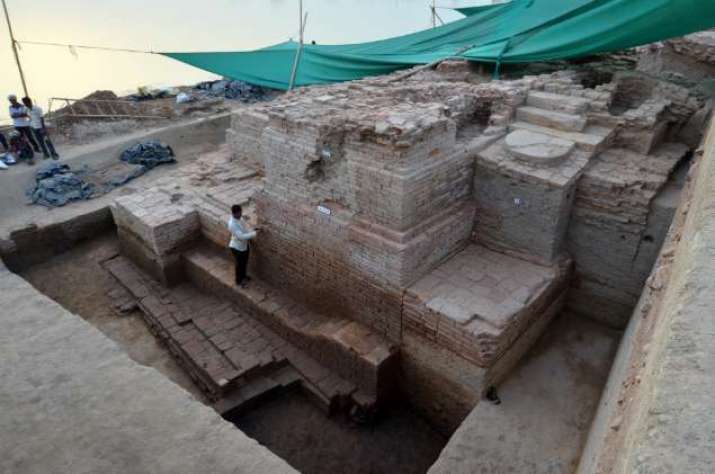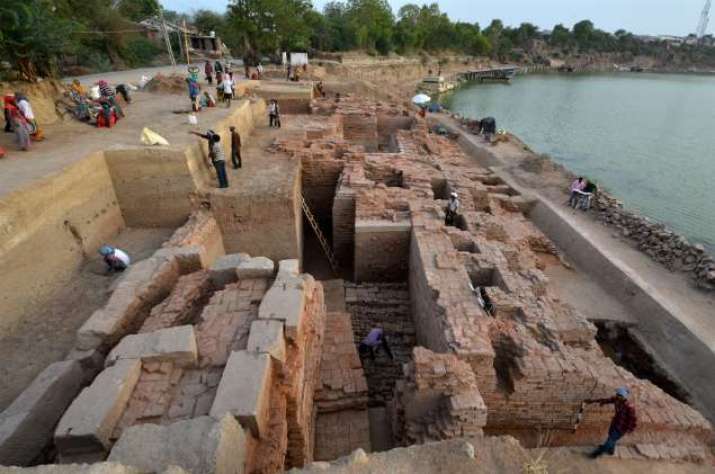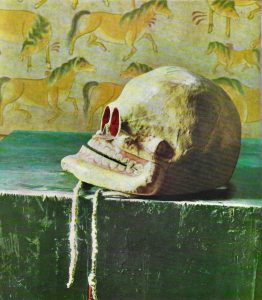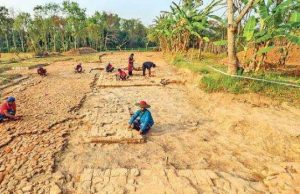
Archaeologists have unearthed a carved Buddha head at a Ramdev Pir temple—a temple dedicated to a the local Hindu folk deity Baba Ramdev—at Negardi Village near Taranga in the Indian state Gujarat. According to the Archaeological Survey of India (ASI), the find will further consolidate the work of Excavation Branch V of the ASI, which has expanded the search and excavation of Buddhist-related sites to include northern Gujarat.
“We have found a Buddha head in a Ramdev Pir temple at Negardi Village in Saltasana Taluka, about 10 kilometers north of Taranga Hills,” a senior ASI official told The Times of India. “It is a round face with curly hair and long ears. The eyebrows are arched above half-closed eyes. Depressions can be found on the corners of the lips. A similar image was mentioned in the excavation report for Devni Mori [an important Buddhist site in Gujarat] as ‘Type C.’ We at the moment assume that the head might be belonging to an idol dating back to 4th–5th century CE.”
A team of archaeologists under the leadership of Dr. Abhijit Ambekar, the deputy superintending archaeologist, has been working for the past three years to uncover a number of heritage sites associated with Buddhism in Gujarat and western India. The archaeologists have also uncovered various Buddhist structures in or near the cities of Gunja, Taranga, Vadnagar, and Valabhi, as well as Sharmishtha Lake.
According to experts, the findings indicate that Gujarat has a long Buddhist history. Various forms of Buddhism are thought to have existed through the centuries in the area, which extends from Valabhi, Junagadh, Saurashtrain the southwest, Taranga in the north, and Devni Mori in the east.

“In the past three years, a number of encouraging discoveries have been made,” a senior ASI official said. “While a major structure—measuring 50 x 25 metres, dating back to 5th century—has been found on the banks of Sharmishtha Lake, two cells of a possible monastery were also found from Ghaskol area. The walls and rampart of the city also gave a peek into unbroken sequence of many centuries. The excavations so far have given a detailed account of the town under different rules including Kshatrapa, Solanki, Sultanate, and Maratha.” (The Times of India)
Among the excavated Buddhist sites of the region, Devni Mori is considered to be the most important. Excavated by the state archaeology department between 1959 and 1972, the site houses a monastery and a stupa. Nine buddha statues were found in the stupa, in addition to three 1,700-year-old relic caskets, one of which is believed to contain bodily relics of the Buddha. The remains are now kept at Maharaja Sayajiro University of Baroda in Gujarat.
Historical accounts seem to support the theory that Buddhism flourished in Gujarat over the centuries. The Chinese Buddhist monk, scholar, and translator Xuanzang (602–64), who visited India and the Gujarat region in the seventh century, reported on 1,000 Buddhist monks in “Onan To Pu Lo,” which is thought to be the Anandpur, the old name of Vadnagar. Archaeologists are now searching for a potential monastery in the region that could house such numbers.
See more
New Buddhist footprints discovered in North Gujarat (The Times of India)
ASI expands scope of operations in Vadnagar (The Times of India)
Super-structure unearthed by ASI in PM’s hometown Vadnagar (The Times of India)












